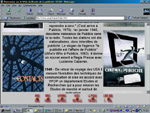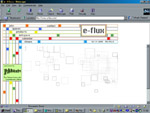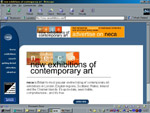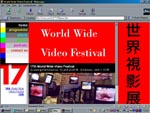|
|
|
http://www.artandculture.com
Winner of the prestigious "Silver award" for the interactive media category in a competition sponsored by the American magazine I.D., art and culture is an exceptional example of the knowledgeable and functional application of the capabilities of Flash technology (Macromedia), that allows the production of dynamic and animated Web sites which too often risk remaining just windows full of spectacular effects. The site presents sophisticated and lean graphics and intuitive navigation, and is divided into six main sections (Design Arts, Film, Literature, Music, Performance Arts, and Visual Arts). The topics span from industrial design to architecture, from contemporary literature to film criticism, from electronic music to dance and international theater. In addition to a calendar pointing out events concerning the many areas of interest, the site hosts "READ", an interesting magazine of contemporary culture that collects articles from the whole Web in its section called "Artnews".
|

|
http://www.ucad.fr/pub
Opened in Paris last November, the Museum of Advertisement, designed by Jean Nouvel, is entirely devoted to the world of advertisement, with a large collection of posters, objects, films, and television, radio and newspaper ads. In the first few days of the museum opening, the corresponding Internet site, accessible from the home page, was a kind of shop window where images, short commercials and sentences followed one another repeatedly and continuously. Now the on line version of the museum, displaying a strangely not very refined graphic layout, can be found inside UCAD (Central Union of Decorative Arts) official site, hosting also a museum of fashion and textiles. In the site it is possible to find useful information on the museum, its collections, its documentation center, its media library, and a calendar of future events. One can also take a virtual trip inside the advertisement universe through its evolution (from the history of affiche to that of the famous trademarks) and its language (a vast bibliography and a sort of glossary are offered), and access a valuable list of addresses of schools, restoration businesses, merchants, and of all those gravitating around the colorful world of advertisement.
|

|
http://www.e-flux.com
e-flux is a New York organization founded in 1998 with the purpose of providing information on contemporary art shows and cultural events through a mailing list that, in a short time, gathered a large number of addresses of international art professionals. The site is divided into many sections, among which are: calendar, a space devoted to the recommendation of events, even though, for the time being, only those happening in the city of New York are presented; shows, which collects a series of links of private galleries, arts fairs, and several exhibition spaces; spaces, a sort of electronic bulletin board of offerings, requests, and swaps. Of particular interest is the section netspace, holding a few art projects. Worthy of note is Transmute by Joshua Decter, a kind of "artist’s virtual program" which makes it possible to produce new versions of existing works with a simple play of random superimposing and composing, thus generating unexpected visual combinations. e-flux on line is sponsored by Parkett, a four-monthly magazine in English and German published in close collaboration with international artists. The long list includes: Laurie Anderson, Richard Artschwager, Georg Baselitz, Matthew Barney, Louise Bourgeois, Francesco Clemente, Peter Fischli/David, and many others.
|

|
http://www.newexhibitions.com
New Exhibitions of Contemporary Art represents the most popular and complete list of contemporary art shows taking place in London, Scotland, Ireland, and Wales. It has been published since 1978 by Kay Roberts, and distributed free of charge all over England. Now it is possible to access the valuable list directly through the Internet, thanks to an agreement between neca collecting the information, and Artlogic Media dealing with the graphical and technical aspects. The site, which presents mainly text, has a functional search engine through which it is possible to retrieve information on current exhibitions by inserting the name of a gallery or an artist, the title of a show, or more generically the geographical area. For many exhibition spaces, particularly in London, the site provides detailed maps highlighting their location, just like a virtual phone book "City Guide" for the Arts.
|

|
http://www.wwvf.nl
WWVF stands for WorldWide Video Festival, an annual video and multimedia show (installations, dvd, cd-rom, Internet projects) in Amsterdam,now in its eighteenth year. The site, in English and Dutch, with a very colorful and at the same time sparse graphic layout, offers a great deal of information about the festival. During last year’s event some video-portraits of many participating artists answering various questions were produced. Their answers were used as subtitles for their portraits, now on view in the site. The "artists" section provides a complete list of all the artists with references to selected works and, in some cases, a series of external links to explore the subject (for example Nicholas Thely’s conversation with Robert Cahen, or Zoe’s world – Zoe Beloff’s world). The program of the next festival and of the usual accompanying events, taking place from September 13 to 17, 2000 has not been published yet, but on line it is possible to get the form and the rules to participate in the selection. The requested material must be delivered by April 15, 2000.
|

|
|
|
|